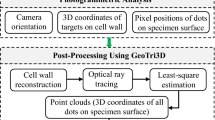Abstract
A data processing method was proposed for eliminating the end restraint in triaxial tests of soil. A digital image processing method was used to calculate the local deformations and local stresses for any region on the surface of triaxial soil specimens. The principle and implementation of this digital image processing method were introduced as well as the calculation method for local mechanical properties of soil specimens. Comparisons were made between the test results calculated by the data from both the entire specimen and local regions, and it was found that the deformations were more uniform in the middle region compared with the entire specimen. In order to quantify the nonuniform characteristic of deformation, the non-uniformity coefficients of strain were defined and calculated. Traditional and end-lubricated triaxial tests were conducted under the same condition to investigate the effects of using local region data for deformation calculation on eliminating the end restraint of specimens. After the statistical analysis of all test results, it was concluded that for the tested soil specimen with the size of 39.1 mm × 80 mm, the utilization of the middle 35 mm region of traditional specimens in data processing had a better effect on eliminating end restraint compared with end lubrication. Furthermore, the local data analysis in this paper was validated through the comparisons with the test results from other researchers.
Similar content being viewed by others
References
Rowe P W, Barden L. Importance of free ends in triaxial testing[J]. Journal of the Soil Mechanics and Foundations Division, 1964, 90(1): 1–27.
Bishop A W, Green G E. The influence of end restraint on the compression strength of a cohesionless soil[J]. Geotechnique, 1965, 15(3): 243–266.
Raju V S, Sadasivan S K, Venkataraman M. Use of lubricated and conventional end platens in triaxial tests on sands[J]. Soils and Foundations, 1972, 12(4): 35–43.
Tatsuoka F, Molenkamp F, Torii T et al. Behavior of lubrication layers of platens in elements tests[J]. Soils and Foundations, 1984, 24(1): 113–128.
Lee K L. End restraint effects on undrained static triaxial strength of sand[J]. Journal of the Geotechnical Engineering Division, 1978, 104(6): 687–704.
Lade P V, Wasif U. The effect of end restraint of volume change and particle breakage of sands in triaxial tests[C]. In: Advanced Triaxial Testing of Soil and Rock, ASTM STP 977. Philadelphia, USA, 1988. 706–714.
Goto S, Tatsuoka F. Effects of end conditions on triaxial compressive strength for cohesionless soil[C]. In: Advanced Triaxial Testing of Soil and Rock, ASTM STP 977. Philadelphia, USA, 1988. 692–705.
Ueng T S, Tzou Y M, Lee C J. The effect of end restraint of volume change and particle breakage of sands in triaxial tests[C]. In: Advanced Triaxial Testing of Soil and Rock, ASTM STP 977. Philadelphia, USA, 1988. 679–691.
Airey D W. Finite element analysis of triaxial tests with different end drainage conditions[C]. In: Proceedings of the 7th International Conference on Computer Methods and Advances in Geomechanics. Cairns, Australia, 1991, Vol. 1. 225–230.
Jeremic B, Yang Z, Sture S. Numerical assessment of the influence of end conditions on constitutive behavior of geomaterials[J]. Journal of Engineering Mechanics, 2004, 130(6): 741–745.
Lee K L, Seed H B. Discussion on Importance of free ends in triaxial testing [J]. Journal of the Soil Mechanics and Foundations Division, 1964, 90(6): 167–179.
Sun Shuguo, Chen Zhenghan, Leng Wen et al. Development of laser measuring system to measure radial displacement of triaxial specimens based on high precision PSD[J]. Chinese Journal of Geotechnical Engineering, 2007, 29(10): 1587–1590 (in Chinese).
Miao Qiangqiang, Chen Zhenghan, Sun Shuguo et al. Improvement of laser measurement system for radial deformation of triaxial specimens[J]. Chinese Journal of Rock Mechanics and Engineering, 2011, 30(2): 427–432 (in Chinese).
Alshibli K A, Al-Hamdan M Z. Estimating volume change of triaxial soil specimens from planar images[J]. Computer-Aided Civil and Infrastructure Engineering, 2001, 16(6): 415–421.
Shao Longtan, Wang Zhupin, Han Guocheng et al. Digital image processing technique for measurement of the radial deformation of specimen in triaxial test[J]. Chinese Journal of Geotechnical Engineering, 2001, 23(3): 337–341 (in Chinese).
Philippe J, Francoise G, Lyesse L et al. Automated digital image processing for volume change measurement in triaxial cells[J]. Geotechnical Testing Journal, 2006, 30(2): 98–103.
Bagherieh A R, Habibagahi G, Ghahramani A. A novel approach to measure the volume change of triaxial soil samples based on the image processing[J]. Journal of Applied Sciences, 2008, 8(13): 2387–2395.
Wang Zhupin. Method of Digital Image Measurement for Soil Specimen Deformation in Triaxial Tests and Its Application[D]. Dalian University of Technology, Dalian, China, 2001. 63–66.
Dong Jianjun. Study of Stress-Strain Characteristics of Unsaturated Compacted Soil Based on Digital Image Measurement[D]. Dalian University of Technology, Dalian, China, 2007. 73–75.
Wang Jian, Guo Ying. Deformation study on triaxial specimen using the digital image measuring system[J]. Northwestern Seismological Journal, 2011, 33(Suppl): 175–180.
Yao Tao. Study of Deformation and Strength of Loess with Triaxial Test Based on Digital Image Measurement[D]. Dalian University of Technology, Dalian, China, 2008. 38–40.
Shao Longtan, Liu Xiao, Guo Xiaoxia et al. Whole surface deformation measurement of triaxial soil specimen based on digital image processing[J]. Chinese Journal of Geotechnical Engineering, 2012, 34(3): 409–415 (in Chinese).
Zhang Zhengyou. A flexible new technique for camera calibration[J]. IEEE Transactions on Pattern Analysis and Machine Intelligence, 2000, 22(11): 1330–1334.
Liu Xiao, Shao Longtan, Guo Xiaoxia et al. Accuracy analysis of digital image processing system for triaxial specimens’ whole surface deformation measurement[J]. Chinese Journal of Rock Mechanics and Engineering, 2012, 31(Suppl): 2881–2887 (in Chinese)
Author information
Authors and Affiliations
Corresponding author
Additional information
Supported by Major State Basic Research Development Program of China(“973” Program, No. 2010CB731502).
Liu Xiao, born in 1982, male, Dr.
Rights and permissions
About this article
Cite this article
Liu, X., Shao, L. & Guo, X. Local data analysis for eliminating end restraint of triaxial specimen. Trans. Tianjin Univ. 19, 372–380 (2013). https://doi.org/10.1007/s12209-013-2000-1
Accepted:
Published:
Issue Date:
DOI: https://doi.org/10.1007/s12209-013-2000-1




